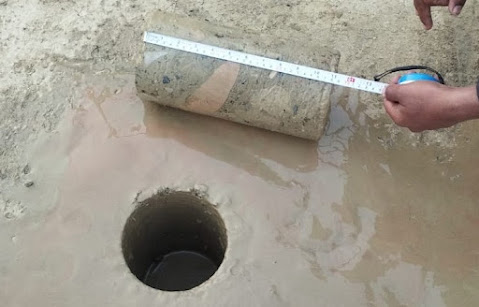The quality control majors in full-depth
reclamation (FDR) with cement involve various
aspects of the construction and testing process. Some of the key quality
control measures include:
Grain Size Analysis:
The gradation of the in-situ pulverized
materials should meet the criteria given in MoRD specifications as presented in
Table 1. However, if the gradation obtained is different, then additional
material of desired sizes shall be mixed and mix design can be done subjected
to meet the desired gradation, strength, and durability criteria.
|
IS Sieve |
Percent by wt. Passing within the
Range |
|
53 mm |
100 |
|
37.5 mm |
95-100 |
|
19 mm |
45-100 |
|
9.5 mm |
35-100 |
|
4.75 mm |
25-100 |
|
600 micron |
8-65 |
|
300 micron |
5-40 |
|
75 micron |
0-10 |
However, form site it is observed that best
result is obtained when ratio between Aggregate (Course Size particles retained
on 4.75 mm Sieves) and Soil ( Fine Size particles passing through 4.75mm
Sieves) range from 60:40 to 40:60 .
Moisture Content (OMC)
& Maximum Dry Density (MDD):
Optimum Moisture Content (OMC):
OMC is the moisture content at which a soil
exhibits the maximum dry density during compaction. In other words, it is the
moisture content at which a soil is most easily compacted to achieve the
highest density. The OMC is a crucial parameter in construction projects
because it helps determine the ideal moisture content at which the soil can be
compacted to achieve maximum strength and stability.
Maximum Dry Density (MDD):
MDD is the maximum mass (density) of a soil
achieved when it is compacted at a specific moisture content. It represents the
density of the soil when all its voids are filled with the optimum amount of
water. MDD is an important parameter because it indicates the highest
achievable density for a given soil at a particular moisture content. This
density is critical for evaluating the stability and load-bearing capacity of
the soil.
The optimum moisture content and maximum
dry density are crucial factors in the full-depth reclamation (FDR) process.
These values are determined through laboratory analysis and trial cement
contents.
Stabilizer Dosage
& Additive Dosage :
Stabilizer Dosage:
The stabilizer dosage in full-depth
reclamation (FDR) is a crucial factor in the pavement rehabilitation process.
The stabilizer, typically a cementitious material like cement or fly ash, is
added to the reclaimed material to improve its strength and durability. The
specific stabilizer dosage used in FDR can vary based on the mix design,
project requirements, and the type of stabilizer being utilized, such as
portland cement or blended cement. Dosages are obtained from laboratories mix design
by varying the cement content in FDR mix papered in laboratories to obtain
desire result.
Additive
Dosage :
Full-Depth Reclamation (FDR) is a pavement
rehabilitation technique that involves recycling the existing pavement and
underlying materials to create a stabilized base for a new road surface.
Additives are often used in FDR to enhance the properties of the reclaimed
material. The choice of additives depends on the specific characteristics of
the existing materials and the desired properties of the reclaimed base.
Both Stabilizer and additive dosage are obtained from laboratory from hit and trail method with varying the quantity of one or both to obtain desire result.
Coring of Completed
Work:
Coring of completed work in Full-Depth
Reclamation (FDR) refers to the process of extracting core samples from the
rehabilitated pavement structure after 7 Days or 28 Days . This procedure is
essential for quality control and assurance, allowing engineers and inspectors
to assess the properties and characteristics of the reclaimed material and
ensure that it meets the specified design requirements. Core sampling is a
common practice in construction and rehabilitation projects to verify the
actual conditions of the material in place.
The cores can be used to verify FDR layer thickness. However, it is not recommended to use compressive strength results from core samples alone as an acceptance criterion. Unlike concrete, issues with the lower strength FDR and coring method may cause internal damage to the core, resulting in reduced strength results. Although compressive strength results from cores should not be used as an acceptance criterion, the results can be a good indicator of whether the FDR layer is hardening properly. The strength test results obtained from the cubes or cylinders prepared at the
.png)
.png)
.png)

.png)
Comments
Post a Comment